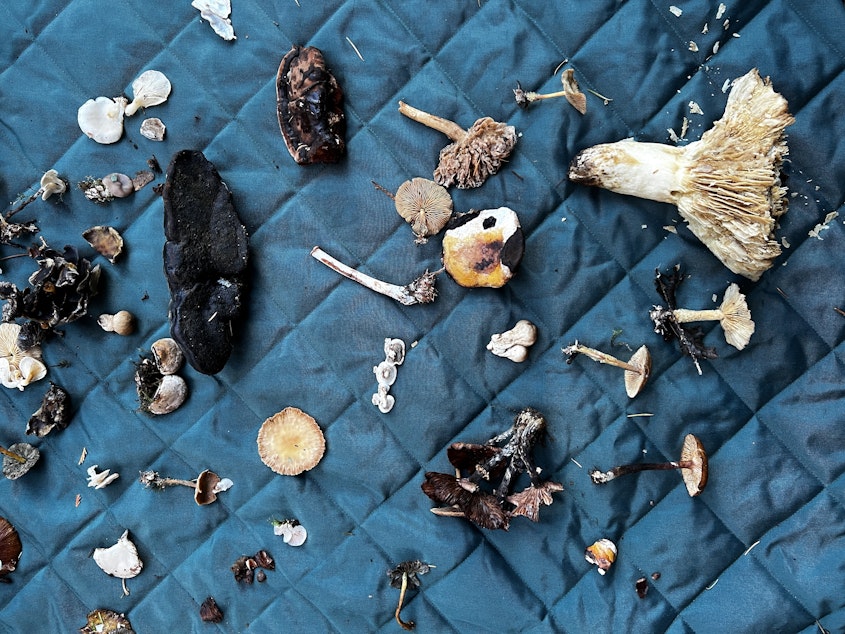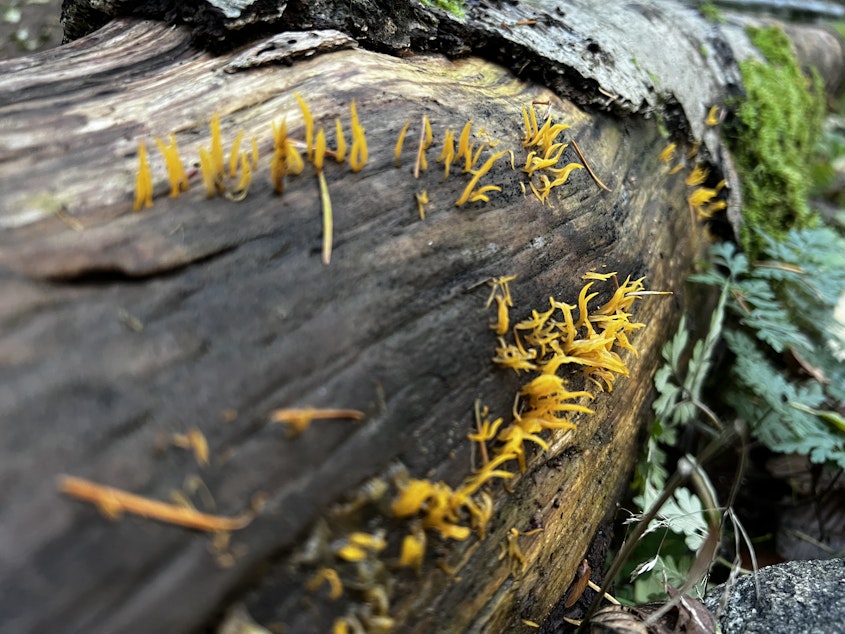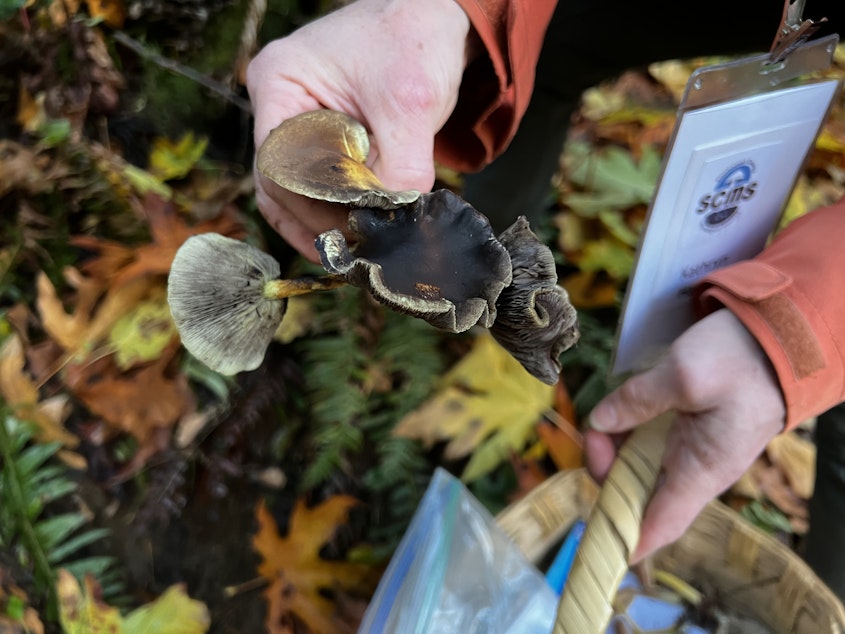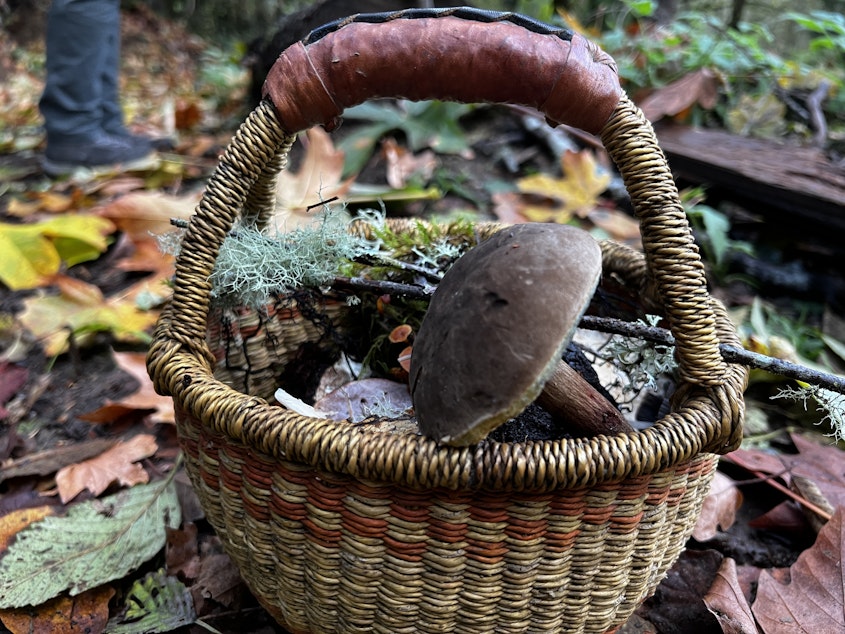Mushrooms are abundant in Puget Sound. Here's how to forage them ethically

Puget Sound mushroom clubs are proud to be some of the biggest in the country.
Our rainy climate helps a wide variety of fungi thrive in the wild, and the enthusiasts who collect them help the knowledge of fungi spread like spores on your fridge’s leftovers.
But picking mushrooms isn't a no-impact activity for our local woodlands -- so how can you ethically forage like the pros?
Kathryn Hanser isn’t afraid of a little dirt — or, little mushrooms.
She kneels by a trailside log soaked with rain, and moss dangles down either side. What's caught her eye are a series of small, neon orange hairs. With a specialized mushroom knife — a curved, two-inch blade — Hanser digs into the soft wood.
"If you're getting something to just ID it, you want to get some of the substrate," she says, in reference to the wood she's plying into." I'm not sure exactly what it is, but just from the texture of the wood, I'm going to guess it was a conifer."
Hanser's initial ID is that those orange, nettle-like protrusions are a kind of coral fungi — one of many mushrooms identifiable by their form.

Sponsored
Nearby, other foragers shout out their finds. It's an evening expedition with the Snohomish County Mycological Society at Lord Hill Regional Park, just outside of Monroe. The group of about 30 people is a mix of club members and first-time foragers.
Along the way, Hanser does her best to identify the latest fungi to make an appearance.
For identification, she starts by cutting the cap, or bulb: Is it smooth or cracked, and what shape is it? Second, she looks at the gills, the partitioned, frilly bits underneath: Are they thin, sharp? Are they in straight lines, or do they branch?
Then Hanser looks to understand the spores, which can be shaken out onto a white piece of paper — kind of like a fingerprint for a mushroom.
"First thing, especially with gilled and pored mushrooms, they drop spores," Hanser says. "And a lot of times, the photographic keys that you use will separate it out by spore print color."
Sponsored
Then comes odor, one of the key methods for telling between mushrooms that look similar, but may or may not be toxic, such as matsutake mushrooms, which have a poisonous lookalike known as the amanita smithiana, which can damage kidneys. For reference, foragers want the mushroom that smells like cinnamon candy and old gym socks.
From there, foragers can use a variety of break and peel tests to determine mushroom varieties, alongside identifiers of where the mushroom was found (on a tree? Which variety?) and how its stem is formed (is it ringed or smooth?).
Hanser looks to another mushroom, this time sprouting near a tree, with faint beige tendrils.
"It's under hemlock — this one's probably a decomposer," she says. "What I've done with this one is I've just cut the cap off of one that looks like it's a fairly mature specimen. You can see how it's flattened out as opposed to being more incurved than the younger ones are."
She guesses it could be Cortinarius, a broad genus of mushrooms, although it's missing rings along its stem — so she takes a sample to more closely identify later on.
Sponsored

When harvesting, Hanser is careful to not pull and rip the mushroom from the ground. The main body of the organism is under the soil, tree, or log it's found on. The front-facing bulbs and stems are largely used to spread spores and reproduce, meaning careful harvesting doesn't actually harm the fungi. That allows foragers to return to the same mushrooms across seasons as the organism spreads and regrows its bulbs.
Though, for Hanser, the most interesting finds are hard to notice.
"When you think about mushrooms, people think of a stem and a cap. But there's such a wide range of forms," she says. "Powdery mildews are actually amazing, but you've got to get those under the microscope to see the appendages, and they can be really gorgeous."
While today's outing is to introduce beginners to the excitement of foraging, however, Hanser notes the importance of conscientious picking. Heavily trafficked mushroom spots, like public parks, can strain mushrooms and keep them from growing.
Sponsored
"Anecdotally, I've had a number of older members of the club who've said that they've shared their foraging areas and at this point, they said they're not finding anything there anymore because they've been over-foraged."
To protect mushrooms, regions throughout Washington have varied rules and restrictions for foraging, ranging from limits on the gallons of mushrooms harvested to outright bans, like in Seattle's public parks.
"It's a bit like picking berries. You're not taking the mushroom, you're just picking an acorn or taking a berry," she says. "That said, you still need to be mindful."


Sponsored
Further ahead on the trail, Melany Kahn is leading a group of kids on their excursion. Kahn grew up foraging with her parents in Vermont, where she would explore the woods as her father stopped to paint landscapes. She's also the author of "Mason Goes Mushrooming," a children's book about ethical foraging.
Part of her message today is destigmatizing mushrooms and the fear of poisonous fungi.
"Everybody says, 'Don't touch that mushroom,' as if they were all poisonous. Not true. In fact, very few mushrooms are poisonous," Kahn says. "Mushroom education, fungi in general, has been cut off from children by this mentality that all mushrooms are bad. The opposite is true."
At the same time, Kahn says she isn't advocating eating just any mushroom a forager comes across. Rather, she hopes education and curiosity can better equip enthusiasts to be safe and smart with their mushrooms.
"The best way to learn how to mushroom hunt is with a club [and] to go out in person," Kahn says. "Immerse yourself in the environment and see where the mushrooms grow, around which trees, on what slope, in what conditions, with which rain and which sun — and learn them gradually, one by one."





